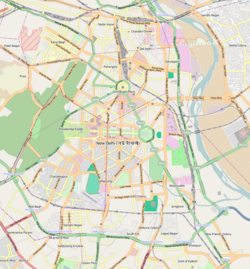| Fatehpuri Mosque | |
|---|---|
 The mosque façade and entrance, in 2018 The mosque façade and entrance, in 2018 | |
| Religion | |
| Affiliation | Sunni Islam |
| Ecclesiastical or organizational status |
|
| Leadership | Mukarram Ahmad (imam) |
| Status | Active |
| Location | |
| Location | Chandni Chowk, Old Delhi, Central Delhi |
| Country | India |
 | |
| Geographic coordinates | 28°39′24″N 77°13′21″E / 28.65667°N 77.22250°E / 28.65667; 77.22250 |
| Architecture | |
| Type | Mosque architecture |
| Style | Mughal |
| Founder | Fatehpuri Begum (wife of Shahjahan) |
| Completed | 1650 |
| Specifications | |
| Dome(s) | One (maybe more) |
| Minaret(s) | Two |
| Spire(s) | Two (maybe more) |
| Materials | Red sandstone |
The Fatehpuri Mosque, also Fatehpuri Masjid, is a 17th-century Sunni mosque, located at the western end of the oldest street of Chandni Chowk, in the Old Delhi neighbourhood of Delhi, India. The mosque is opposite the Red Fort and, after Jama Masjid, is the second largest mosque in Delhi.
History
The Fatehpuri Masjid was built in 1650 by Fatehpuri Begum, one of wives of Emperor Shah Jahan, who was from Fatehpur Sikri, and the mosque at Taj Mahal is also named after her.
The British auctioned the mosque after the 1857 war to Rai Lala Chunnamal for Rs. 19,000 (whose descendants still live in the Chunnamal haveli in Chandni Chowk), who preserved the mosque. Later in 1877 it was acquired by the Government in exchange for four villages and was restored to the Muslims at the Delhi Durbar when the British allowed the Muslims back in Old Delhi. A similar mosque, called Akbarabadi Mosque, built by the Akbarabadi Begum, was destroyed by the British.
The Khari Baoli, which is today Asia's largest spice market, gradually developed after the construction of the mosque.
Mufti Mukarram Ahmad is the chief mufti and hereditary imam of the mosque, succeeding his father, Maulana Mufti Mohammad Ahmad (d. AH 1391 (1971/1972 CE)).
The grave of the wife of rebel leader Maulana Abdul Qadir Ludhianvi is located in the courtyard of the Fatehpuri Mosque.
Architecture
The mosque is built using red sandstone and has a fluted dome with mahapadma and kalash finials. Flanked by twin minarets, the mosque has a traditional design with the prayer hall having seven-arched openings. The mosque has single and double-storeyed apartments on the sides.
The central iwan in the middle is flanked by three arches on each side.
Gallery
-
 1863 map of Shahjahanabad (Old Delhi). Musjid Futtepoori is south of the Lahauri Gate, in the north.
1863 map of Shahjahanabad (Old Delhi). Musjid Futtepoori is south of the Lahauri Gate, in the north.
-
 The mosque in 2017
The mosque in 2017
-
Worshippers offering namaz during Idu’l Fitr, AH 1439 (2017/2018)
-
 The view from the mosque towards the old Delhi market
The view from the mosque towards the old Delhi market
See also
References
- Roy, Ishita (8 March 2024). "What the monuments in Delhi remember". The New Indian Express. Retrieved 8 January 2025.
- Nath, R. (2006). History of Mughal Architecture. Abhinav Publications.
- Muʻīn al-Dīn, Muḣammad; Muʻīn al-Dīn, Akbarābādī Muḣammad (1905). The History of the Taj and the Buildings in Its Vicinity: With 3 Illustrations from Photographs and 2 Plans. Moon Press.
- "Fatehpuri Shahi Masjid: A mute witness to the travails of Dillee". Milli Gazette. 1 May 2000.
- "Beyond the WALL". The Hindu. 25 September 2003. Archived from the original on 7 November 2003. Retrieved 19 December 2018.
- "In memory of a pious Begum". The Hindu. 3 October 2005. Archived from the original on 28 June 2009.
- "Punjab mosque opens for prayers after 74 years". www.awazthevoice.in. Retrieved 4 October 2022.
- Singh, Dr Aradhana (2023). "Monumental Legacy of Mughal Women" (PDF). Samvedna. V (2). India: maitreyi.ac: 33. ISSN 2581-9917. Retrieved 8 January 2025.
External links
[REDACTED] Media related to Fatehpuri Masjid at Wikimedia Commons
| Emperors | |||||||||
|---|---|---|---|---|---|---|---|---|---|
| Administration |
| ||||||||
| Conflicts |
| ||||||||
| Architecture |
| ||||||||
| See also | |||||||||
| Successor states | |||||||||
| Landmarks of Delhi | |
|---|---|
| Buildings and structures | |
| Religious sites | |
| Memorials | |
| Streets and plazas | |
| Parks and gardens | |
- 1650 establishments in India
- 1650s establishments in the Mughal Empire
- 17th-century mosques in India
- Central Delhi district
- Mosque buildings with domes in India
- Mosque buildings with minarets in India
- Mosque buildings with spires
- Mosques completed in the 1650s
- Mosques in Delhi
- Mughal mosques
- Religious buildings and structures completed in 1650
- Sandstone buildings in India